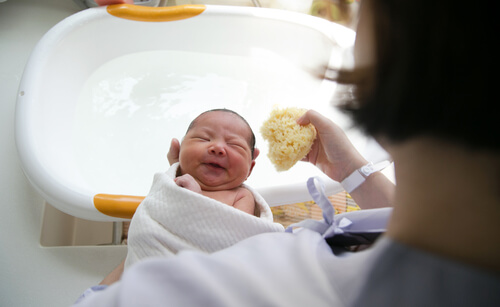What Is Cradle Cap and When Should It Be Treated?

It affects babies’ scalps in the form of yellowish or whitish scabs.
When does cradle cap appear?
Cradle cap usually appears around the second or third week of life and may have the appearance of greasy dry skin. It can be found in children up to 3 years of age.
This type of seborrhoeic dermatitis affects about 10 percent of newborns. The lesions appear on the head, eyebrows, between the eyebrows, behind the ears and sometimes in skin creases.
Cradle cap is related to genetic and meteorological factors. Hormonal imbalances can also cause the sebaceous glands to release excess oils.
They aren’t harmful or painful, but they shouldn’t be removed. Doing so may result in injury or cause infection.
Cradle cap isn’t contagious and is in no way related to poor hygiene.
Causes of cradle cap
Some babies react to the change in nourishment that occurs when they’re born.
During gestation, a baby’s nourishment comes from the placenta. After birth, they get their nourishment from breast milk or formula.
The high levels of fat produce excessive stimulation of the sebaceous glands, leading to cradle cap. Each child is different.
The hormones that the mother passes onto the fetus are also a probable cause. Some suggest it may be an irritation caused by a fungus that grows in the scalp’s sebum.
Contrary to what many think, cradle cap is not a sign of milk intolerance or digestive issues.
Other possible causes include extreme climate conditions, problems in the immune system, stress and certain skin conditions.
It’s worth noting that specialists agree that cradle cap is harmless. However, the underlying causes may not always be harmless, so it’s always important to be attentive.
Atopic dermatitis makes babies more susceptible to cradle cap. This is a general irritation on the skin of a breastfed baby for no apparent reason,
Color and appearance vary depending on the place where cradle cap appears. When on the scalp, cradle cap is white or yellow, and greasy in appearance.
If it’s on the face, it will be reddish in color, accompanied by yellowish scabs. With the right treatment, the skin condition will cure quickly.
It’s important to remember that cradle cap can come back even when children are older.
A problem with a solution
In very slight cases, there is no reason to worry. Cradle cap tends to disappear over the course of several months, without treatment.
If you’d like to speed things up, you can soften it with creams or baby oils until it falls off.
Simply massage the affected area with one of these baby products. Wait a half hour before bathing your child.
You should wash your baby’s head daily with a good pharmacy-bought shampoo, not a cosmetic shampoo.
You should also comb your baby’s hair and apply any treatment your doctor may have prescribed.

Another option is to use a wet sponge and shampoo. Rub your baby’s head very gently until you loosen some of the scabs. Repeat the process every three days with extreme delicacy.
Remember you’re dealing with a newborn’s skin, which is very thin and fragile. Also be extra careful around the soft spot on your baby’s head.
Seborrhoeic dermatitis can extend to the forehead and eyebrows. Olive oil and almond oil can solve this issue, even if there is pus in the scabs.
You can also apply emollients and massage your baby’s scalp. The oils can be left on overnight.
Wash your baby’s head in the morning with a shampoo that won’t dry your baby’s hair. Combing your baby’s hair with a gentle brush will help to remove the scabs.
Signs you should take special precaution
Take precaution if the cradle cap is very large, or if it becomes yellowish with reddish borders. If that’s the case, you should schedule an appointment with your child’s pediatrician.
You should also seek medical attention if the area is bleeding or if it spreads outside of your child’s scalp and forehead.
The pediatrician may recommend corticoid creams, antibiotic ointments, and antifungal creams.
Remember that while you may not find cradle cap aesthetically pleasing, it’s a condition that’s easy to fix and that, in and of itself, doesn’t present any risk to your baby’s health.
This text is provided for informational purposes only and does not replace consultation with a professional. If in doubt, consult your specialist.
